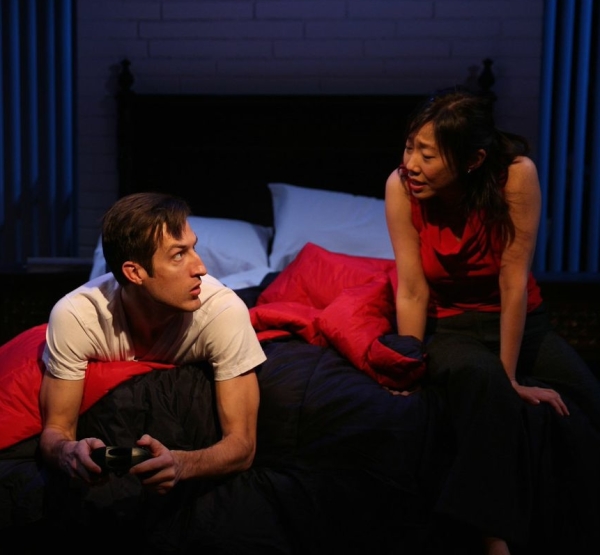Long Story Short

(© Matthew Murphy)
Fifty years is a long time to be married, especially in an era of celebrity weddings that end in annulment shortly after the party begins. Yet there are people who still manage to find their one true love and stay attached, for better or worse, until death do they part. In Long Story Short, a new musical by Brendan Milburn and Valerie Vigoda at 59E59 Theaters, we meet one such couple and follow their lives over five decades, for richer or poorer, in sickness and in health. As a show it has a lot going for it, even if it doesn't always find originality in well-trodden territory.
Based on David Schulner's two-character play An Infinite Ache, Long Story Short begins after a blind date. Charles (Bryce Ryness) is a neurotic Jew who has recently relocated to Los Angeles. He's been set up with Hope (Pearl Sun), an Asian-American California native who didn't actually think they were on a date. But somehow they've landed in his apartment, and she's had a bad reaction to the cheap wine they consumed. Next thing you know, they're getting married, having children, finding themselves on different paths, and eventually discovering true happiness.
What Long Story Short does exceedingly well is present how the passage of time sneaks up on us. As in the real world, life flashes before our eyes in an instant — in one second, we're 20somethings who don't know any better, in the next, we're 70 and looking for our hearing aids. In Kent Nicholson's deftly theatrical staging, shifts are noted through the mere reversal of a bedspread and the addition of wall decor. Scenic designer David L. Arsenault provides a realistic-looking bare bedroom that over the course of the show becomes a home, while Kirche Leigh Zeile provides the stars with costumes that shift in tone as they grow in age. Subtle changes in period are articulated through the lighting by Grant W.S. Yeager.
Musically, time has the tendency to change over the course of a single song. Perhaps the best example is the stunning "There She Goes," where Charles and Hope watch their daughter, Julia, go off to first grade, make her Bat Mitzvah, puke after drinking, and enter college. Milburn and Vigoda's attractive score knows just the right buttons to push without ever getting too emotionally manipulative. Their book, on the other hand, has an unfortunate penchant for overexplaining and oversimplifying. It's in these moments that Nicholson's direction takes on a plodding quality, as though the pace should be picked up.
Ryness and Sun make a believably mismatched couple, with powerful voices and quirky charisma that suits them both individually and as a pair. While they don't always look comfortable as the young versions of Charles and Hope, these youngish performers are strangely at ease as their older selves, playing the last 20 minutes with a deeply felt connection. There are waterworks to be shed, as there would be for any couple with that long a history and an undying love that will eventually come to an end.











